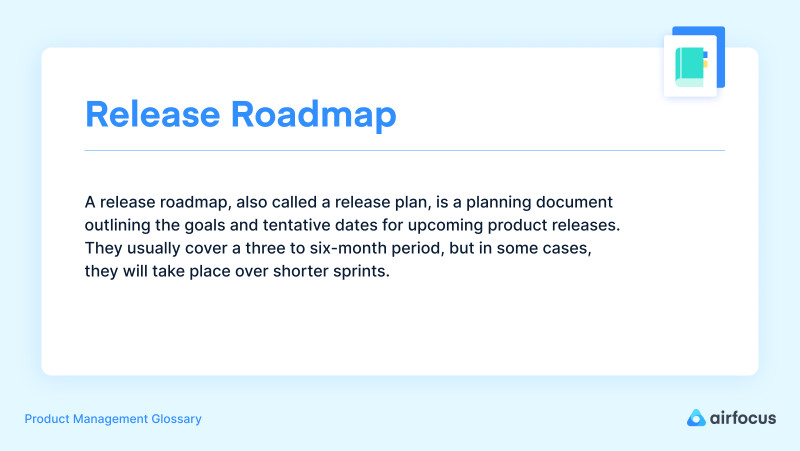Release Roadmap
What is a release roadmap?
Release roadmap definition
A release roadmap, also called a release plan, is a planning document outlining the goals and tentative dates for upcoming product releases. They usually cover a three to six-month period, but in some cases, they will take place over shorter sprints.
Release roadmaps outline a product's development timeline, including the features, enhancements, and bug fixes that will be added to each release. They allow development, QA, and product marketing teams to have clear goals and expectations while clearly defining roles when planning releases.
The release roadmap sets expectations for customers and team members and serves as a management tool to track progress and ensure milestones are met.
Why are release roadmaps important?
Release roadmaps are important for planning and tracking the progress of a product’s development. Without them, teams can lack clarity on what milestones to prioritize and when to meet them.
Roadmaps also help bridge the gap between the customer’s vision and the team's delivery. Having a detailed roadmap makes it easier to break down and understand what features will be available in upcoming releases.
Benefits of release roadmaps
Roadmaps are an essential tool in the world of product management, as they offer a clear view of a project's progression toward its goals. They ultimately outline the immediate actions and plans the team is currently working on while guiding the product development to ensure it is moving in the right direction. When it comes to software releases, roadmaps can be especially beneficial for both the development team and stakeholders.
Release roadmaps provide a structured timeline that outlines when new features or updates will be released to the public, allowing stakeholders to better plan and prepare for upcoming changes. In addition, they can ensure that all team members are working towards the same goal and that everyone is aware of the project's progress.
Elements of release roadmaps
Release roadmaps will look different for each product and should be customized to suit your needs.
That said, there are still specific elements that each roadmap should include, like:
Dates of proposed releases: Each release roadmap should have a clear timeline of the proposed release dates.
Plans for each product release: Each product release should have its own detailed plans outlining all features, bug fixes, enhancements, and other improvements.
Subsequent iterations: It's important to plan for subsequent iterations after the initial release.
Feature development: Each feature should have its own timeline for development so team members know what to prioritize and when it needs to be completed.
The features each release will contain: The roadmap should also include details on what each release will contain so stakeholders know when they can expect new features to be available.
Best practices for creating release roadmaps
Creating a successful release roadmap requires careful coordination and planning. You can create one perfectly suited for you and your team by following a few best practices.
Have clear goals and expectations: Know exactly what you are looking to achieve. Clear goals and expectations help keep everyone on track to build the best possible product.
Prioritize your release roadmap: Knowing what needs to happen and when is important. Be sure to prioritize your release plan so your team works on the most pressing tasks first.
Clearly define roles when planning releases: The development process gets a lot easier when everyone knows what they’re responsible for, so make sure roles are clear and responsibilities are spread out across the team.
Divide your release roadmap into increments: Breaking down larger projects into milestones helps you better track your progress and makes prioritization easier.
Keep internal deadlines flexible: Things don't always go according to plan, so leave some room for things to change.
Use templates and a purpose-built roadmapping platform: A purpose-built roadmapping tool can help you quickly and easily create high-quality release roadmaps that are perfectly suited to your needs. Try airfocus’ release plan template to make creating a release roadmap a breeze.

General FAQ

Glossary categories
Build great roadmaps

Experience the new way of doing product management








